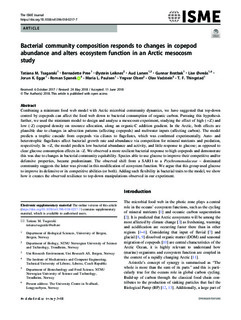| dc.contributor.author | Tsagaraki, Tatiana Margo | |
| dc.contributor.author | Pree, Bernadette | |
| dc.contributor.author | Leiknes, Øystein | |
| dc.contributor.author | Larsen, Aud | |
| dc.contributor.author | Bratbak, Gunnar | |
| dc.contributor.author | Øvreås, Lise | |
| dc.contributor.author | Egge, Jorun Karin | |
| dc.contributor.author | Spanek, Roman | |
| dc.contributor.author | Paulsen, Maria Lund | |
| dc.contributor.author | Olsen, Yngvar | |
| dc.contributor.author | Vadstein, Olav | |
| dc.contributor.author | Thingstad, T. Frede | |
| dc.date.accessioned | 2018-10-05T11:37:08Z | |
| dc.date.available | 2018-10-05T11:37:08Z | |
| dc.date.created | 2018-09-03T14:40:05Z | |
| dc.date.issued | 2018 | |
| dc.identifier.citation | The ISME Journal. 2018, 1-12. | nb_NO |
| dc.identifier.issn | 1751-7362 | |
| dc.identifier.uri | http://hdl.handle.net/11250/2566665 | |
| dc.description.abstract | Combining a minimum food web model with Arctic microbial community dynamics, we have suggested that top-down control by copepods can affect the food web down to bacterial consumption of organic carbon. Pursuing this hypothesis further, we used the minimum model to design and analyse a mesocosm experiment, studying the effect of high (+Z) and low (-Z) copepod density on resource allocation, along an organic-C addition gradient. In the Arctic, both effects are plausible due to changes in advection patterns (affecting copepods) and meltwater inputs (affecting carbon). The model predicts a trophic cascade from copepods via ciliates to flagellates, which was confirmed experimentally. Auto- and heterotrophic flagellates affect bacterial growth rate and abundance via competition for mineral nutrients and predation, respectively. In +Z, the model predicts low bacterial abundance and activity, and little response to glucose; as opposed to clear glucose consumption effects in –Z. We observed a more resilient bacterial response to high copepods and demonstrate this was due to changes in bacterial community equitability. Species able to use glucose to improve their competitive and/or defensive properties, became predominant. The observed shift from a SAR11-to a Psychromonodaceae – dominated community suggests the latter was pivotal in this modification of ecosystem function. We argue that this group used glucose to improve its defensive or its competitive abilities (or both). Adding such flexibility in bacterial traits to the model, we show how it creates the observed resilience to top-down manipulations observed in our experiment. | nb_NO |
| dc.language.iso | eng | nb_NO |
| dc.publisher | BMC (part of Springer Nature) | nb_NO |
| dc.rights | Navngivelse 4.0 Internasjonal | * |
| dc.rights.uri | http://creativecommons.org/licenses/by/4.0/deed.no | * |
| dc.title | Bacterial community composition responds to changes in copepod abundance and alters ecosystem function in an Arctic mesocosm study | nb_NO |
| dc.title.alternative | Bacterial community composition responds to changes in copepod abundance and alters ecosystem function in an Arctic mesocosm study | nb_NO |
| dc.type | Journal article | nb_NO |
| dc.type | Peer reviewed | nb_NO |
| dc.description.version | publishedVersion | nb_NO |
| dc.source.pagenumber | 1-12 | nb_NO |
| dc.source.journal | The ISME Journal | nb_NO |
| dc.identifier.doi | 10.1038/s41396-018-0217-7 | |
| dc.identifier.cristin | 1606314 | |
| dc.relation.project | Norges forskningsråd: 225956 | nb_NO |
| dc.relation.project | EC/FP7/603773 | nb_NO |
| dc.description.localcode | © The Author(s) 2018. This article is licensed under a Creative Commons Attribution 4.0 International License. | nb_NO |
| cristin.unitcode | 194,66,10,0 | |
| cristin.unitcode | 194,66,15,0 | |
| cristin.unitname | Institutt for biologi | |
| cristin.unitname | Institutt for bioteknologi og matvitenskap | |
| cristin.ispublished | true | |
| cristin.fulltext | original | |
| cristin.qualitycode | 2 | |

